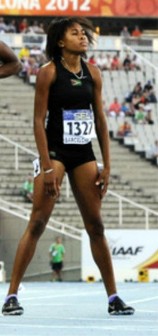Kadecia Baird is Guyanese.
She is also the second fastest 400m female junior competitor in the World this year and her silver medal performance at the International Amateur Athletics Federation (IAAF) World Junior Championships in Barcelona Spain in July was where she made her talent known to the world.
World Junior Champion Ashley Spencer will be a senior competitor next year so Baird, who is just 17-years old, will enter 2013 as the number-one ranked junior quarter miler in the world.
While this is an enormous feat for the Baird (who spent the first 13 years of her life in Guyana) her accomplishment has not seemed to have hit home as yet.
Baird has done Guyana proud on the World scene yet the Government of Guyana (GoG) and the Athletics Association of Guyana (AAG) are yet to get out of the starting blocks in showing gratitude and trying to keep her interested in flying the Golden Arrowhead at future international meets.
 Baird departed these shores just over four years ago, migrating to New York where her athletic career flourished immediately in that enabling environment with proper facilities and specialised coaches. Now, Baird attends Medgar Evers Preparatory High School College and is in her senior year.
Baird departed these shores just over four years ago, migrating to New York where her athletic career flourished immediately in that enabling environment with proper facilities and specialised coaches. Now, Baird attends Medgar Evers Preparatory High School College and is in her senior year.
Next stop, college and competition at the NCAA level.
Baird’s recent time at the World Junior Championships of 51.04s, not only puts her in the gold medal spot at CARIFTA (the region’s premier junior track and field competition), but on pace to shatter the CARIFTA Games 400m record of 51.30.
Since CARIFTA is going to be held in the Bahamas, Baird can expect strong competition from Bahamian World Youth Champion Shaunae Miller who placed fourth in Barcelona behind Baird and the two Americans.
If both competitors are at their best this keen rivalry could produce another impressive record at CARIFTA.
The prestigious Austin Sealy Award is usually given to outstanding athletes for either multiple gold medal performances or impressive record-breaking feats.
Shattering the CARIFTA 400m could make Baird a strong contender to be Guyana’s first ever winner of the Austin Sealy Award which has in the past been won by such world beaters as Usain Bolt, Yohan Blake, Veronica Campbell-Brown and Kirani James.

While these speculations are wonderful to contemplate, the national track and field fraternity firstly and the GoG, secondly, need to ensure that they take all the necessary steps to make this a reality.
Baird already missed out on a chance to represent Guyana at the 2012 Olympic Games; an unfortunate occurrence which showed some negligence on the part of the national track and field association.
Instead of pointing fingers and casting blame as AAG president Colin Boyce did in an August 16th article in another section of the media, the AAG should adopt a more professional and diplomatic approach to resolving issues.
Now Baird is one of the most sought after college prospects especially since she ran the fifth fastest US high school time in history.
To have the born and bred Guyanese athlete continually represent her native land at international competitions is a great opportunity as it could do so much for athletics in Guyana.
Conversely, the severing of the relationships could be equally detrimental.
An athlete of her calibre could easily be persuaded to strap on a red, white and blue body suit and sing lustily “The Star-Spangled Banner” as she is already the top high school quarter miler in the US and second best junior in the world.
While the AAG may be able to get away with their treatment of local athletes such as Alika Morgan, Ernesto Thomas and Jevina Straker, another administrative blunder could force the overseas based athlete to accept other opportunities to perform on the world stage.
Baird does not require as much as local athlete who are in desperate need of facilities and elite coaches.
International athletes such as Baird require a level of professionalism, respect and commitment from their national association/federation.
Somali-born Olympic champion Mohammed Farah captured a pair of gold medals for Great Britain in the 10,000m and the 5000m. Kenya-born Bernard Lagat also gave up his nationality to represent the USA. Scouts are always on the lookout for explosive talent, so the AAG ought to be cognizant of the fact of how easy it is for an elite athlete like Baird to be lured by first world countries which have so much to offer.
Representing one’s birth country is not an obligation in today’s world of athletics. It is a personal choice. Some athletes only chose to represent their native land after realising that they could not make the cut to represent the country where they reside.
But this is far from the situation in Baird’s case. Baird, by virtue of her remarkable talent, now has the choice and ample opportunity to compete at any meet she wishes.
What has Guyana done to ensure that she stays in the red, white, green and black and yellow of her native country?
Absolutely nothing!
Will bickering and pointing fingers encourage an athlete to continue to represent Guyana?
Director of Sport Neil Kumar aired what some consider derogatory views (views which he felt were factual) about Guyana’s performance at the 2012 London Olympic Games but where is his ministry’s token congratulatory remarks or even reward, for Baird’s unprecedented success at the World Junior Championships.
The success of Usain Bolt and other Caribbean athletes have done so much for the development of their respective countries. It is so hard to believe that Baird could be Guyana’s Keshorn Walcott, or Kirani James, or Usain Bolt?
We think not.




